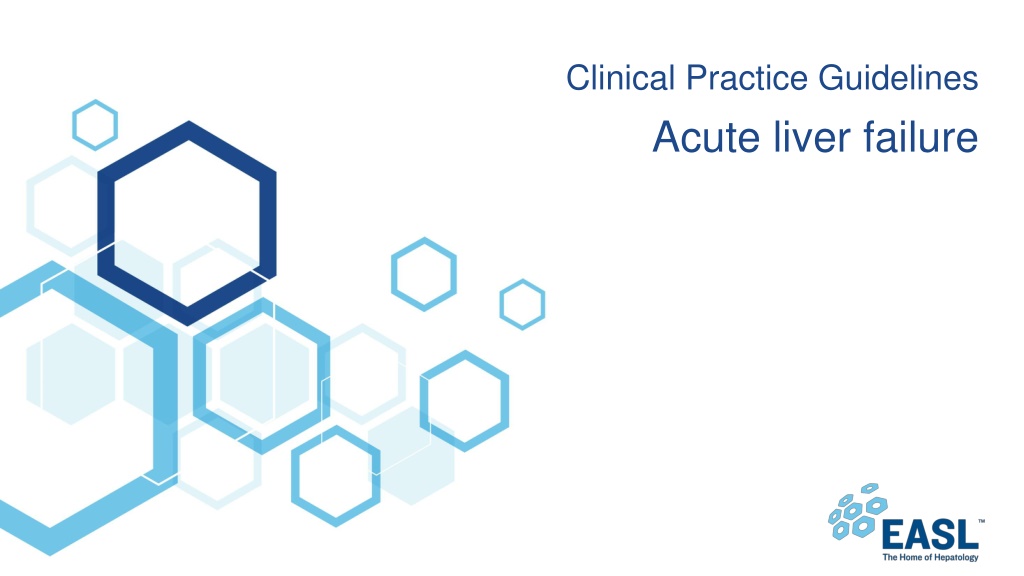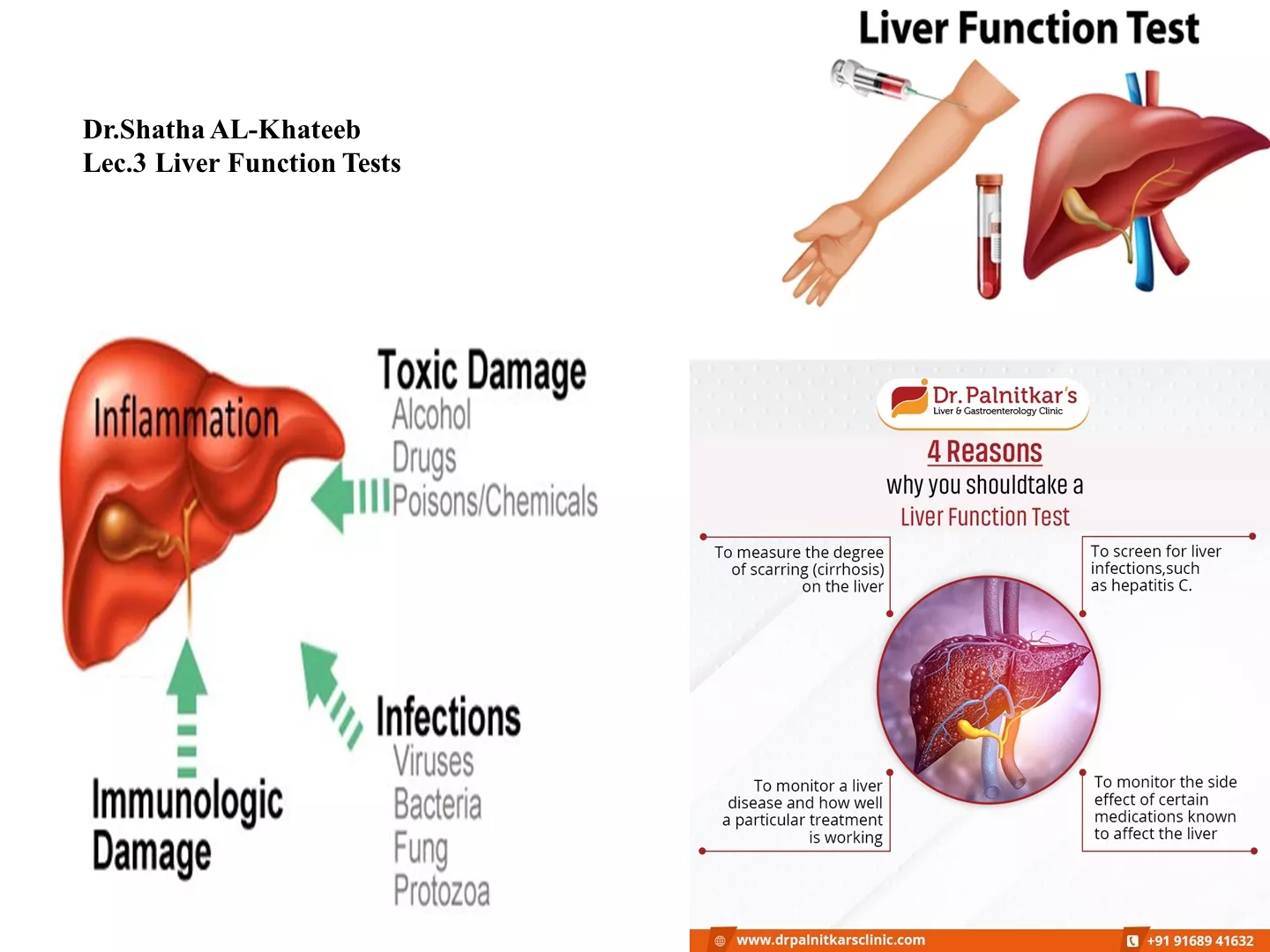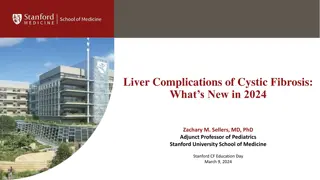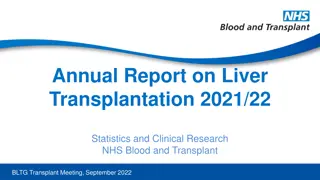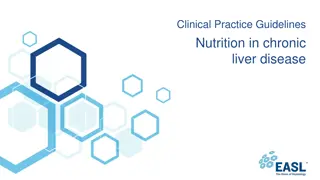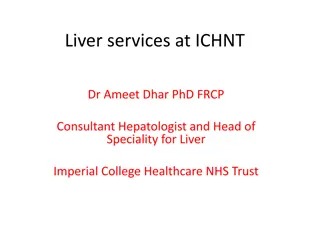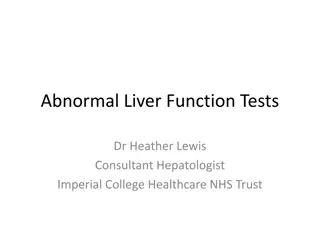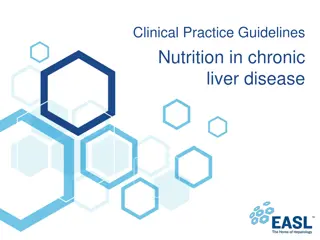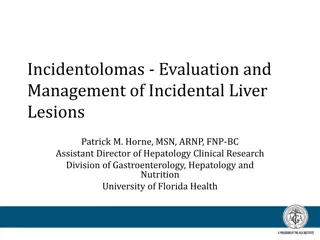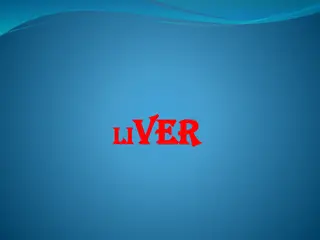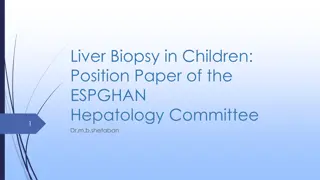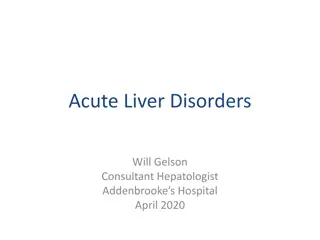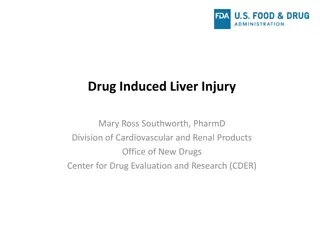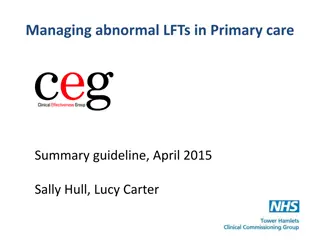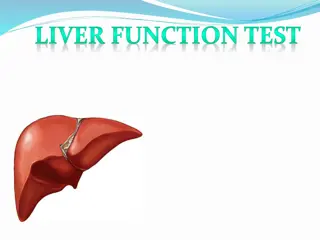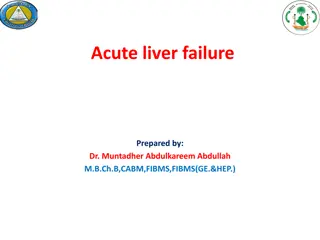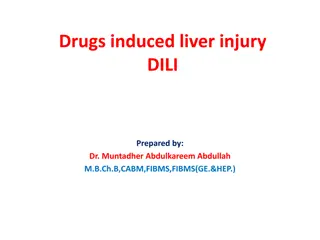Clinical Practice Guidelines for Acute Liver Failure Management
These slides provide a comprehensive overview of the EASL clinical practice guidelines for the management of acute (fulminant) liver failure, published in the May 2017 issue of the Journal of Hepatology. Covered topics include background, guidelines, key recommendations, and considerations for future studies. The grading of evidence and recommendations follows the GRADE system.
Download Presentation

Please find below an Image/Link to download the presentation.
The content on the website is provided AS IS for your information and personal use only. It may not be sold, licensed, or shared on other websites without obtaining consent from the author. Download presentation by click this link. If you encounter any issues during the download, it is possible that the publisher has removed the file from their server.
E N D
Presentation Transcript
Clinical Practice Guidelines Acute liver failure
About these slides These slides give a comprehensive overview of the EASL clinical practice guidelines on the management of acute (fulminant) liver failure The guidelines were published in full in the May 2017 issue of the Journal of Hepatology The full publication can be downloaded from the Clinical Practice Guidelines section of the EASL website Please cite the published article as: European Association for the Study of the Liver. EASL 2017 Clinical Practice Guidelines on the management of acute (fulminant) liver failure. J Hepatol 2017;66:1047 81 Please feel free to use, adapt, and share these slides for your own personal use; however, please acknowledge EASL as the source
About these slides Definitions of all abbreviations shown in these slides are provided within the slide notes When you see a home symbol like this one: , you can click on this to return to the outline or topics pages, depending on which section you are in These slides are intended for use as an educational resource and should not be used in isolation to make patient management decisions. All information included should be verified before treating patients or using any therapies described in these materials Please send any feedback to: slidedeck_feedback@easloffice.eu
Guideline panel Chair Julia Wendon Panel members Juan Cordoba, Anil Dhawan, Fin Stolze Larsen, Michael Manns, Frederik Nevens, Didier Samuel, Kenneth J Simpson, Ilan Yaron, Mauro Bernardi (EASL Governing Board Representative) Reviewers Ali Canbay, Fran ois Durand, Ludwig Kramer EASL CPG ALF. J Hepatol 2017;66:1047 81
Outline Methods Methods Grading evidence and recommendations Background Definition of ALF Sub-classifications Disease burden Principal aetiologies Background Guidelines Guidelines Key recommendations The future for ALF The future for ALF Considerations for future studies EASL CPG ALF. J Hepatol 2017;66:1047 81
Methods Grading evidence and recommendations
Grading evidence and recommendations Grading is adapted from the GRADE system1 Grade of evidence I Randomized, controlled trials II-1 Controlled trials without randomization II-2 Cohort or case-control analytical studies II-3 Multiple time series, dramatic uncontrolled experiments III Opinions of respected authorities, descriptive epidemiology Grade of recommendation 1 Strong recommendation: Factors influencing the strength of the recommendation included the quality of the evidence, presumed patient-important outcomes, and cost 2 Weaker recommendation: Variability in preferences and values, or more uncertainty: more likely a weak recommendation is warranted Recommendation is made with less certainty: higher cost or resource consumption 1. Guyatt GH, et al. BMJ. 2008:336:924 6; EASL CPG ALF. J Hepatol 2017;66:1047 81
Background Definition of ALF Sub-classifications Disease burden Principal aetiologies
Definition and clinical course of ALF In hepatological practice, ALF is a highly specific and rare syndrome, characterized by an acute deterioration of liver function without underlying chronic liver disease SEVERE ACUTE LIVER INJURY (ALI) No underlying chronic liver disease* Liver damage (serum aminotransferases 2 3x ULN) Impaired liver function (jaundice and coagulopathy ) Up to 12 weeks post-jaundice, depending on sub-classification HEPATIC ENCEPHALOPATHY (HE) Crucial for the diagnosis of ALF Mental alterations may be initially subtle Intensive screening at the first sign of HE is mandatory ALF *Patients with an acute presentation of chronic autoimmune hepatitis, Wilson disease and Budd Chiari syndrome are considered as having ALF if they develop hepatic encephalopathy, despite the presence of a pre-existing liver disease in the context of appropriate abnormalities in liver blood tests and coagulation profile; Usually INR >1.5 or prolongation of PT EASL CPG ALF. J Hepatol 2017;66:1047 81
Sub-classifications of ALF Weeks from development of jaundice to development of HE1 >28 weeks = chronic liver disease 0 1 4 12 Acute1 Subacute1 Hyperacute1 Severity of coagulopathy2 +++ ++ + Severity of jaundice2 + ++ +++ Degree of intracranial hypertension2 ++ ++ +/- Chance of spontaneous recovery2 Good Moderate Poor Paracetamol HAV, HEV HBV Non-paracetamol drug-induced Typical cause2 +++ High severity; ++ Medium severity; + Low severity; +/- Present or absent 1. O'Grady JG, et al. Lancet 1993;342:273 5; 2. Bernal W, et al. Lancet 2010;376:190 201; EASL CPG ALF. J Hepatol 2017;66:1047 81
Burden of ALF in Europe Rare syndrome whose true prevalence across Europe is unknown Incidence of virally induced ALF has declined substantially in Europe Remains the most common cause worldwide Most frequent aetiology of ALF in Europe is now drug-induced liver injury (DILI) Grade of evidence Grade of recommendation Recommendations ALF is a rare diagnosis and multicentre data, such as the European Acute Liver Failure Registry, is required to assess outcome, optimal management and conduct appropriate multicentre studies II-2 1 While hyperacute and acute syndromes are usually easily diagnosed, subacute ALF may be mistaken for cirrhosis and the opportunity to be considered for liver transplantation lost II-2 1 Clinical utilization of transplantation varies upon aetiology and region II-3 2 EASL CPG ALF. J Hepatol 2017;66:1047 81
Principal aetiologies of ALF Viral Hepatitis B, A, E (less frequent CMV, HSV, VZV, Dengue) Drugs Toxins Paracetamol, anti-tuberculous, chemotherapy, statins, NSAIDs, phenytoin, carbamazepine, ecstasy, flucloxacillin Amanita phalloides, phosphorus ALF Vascular Budd Chiari syndrome, hypoxic hepatitis Other Wilson disease, autoimmune, lymphoma, malignancy, HLH Pregnancy Pre-eclamptic liver rupture, HELLP, fatty liver of pregnancy EASL CPG ALF. J Hepatol 2017;66:1047 81
Aetiology of ALF varies with geography Top three causes of ALF in selected countries Bangladesh HEV 75% HBV 13% Unknown 6% Germany Other causes* 28% Unknown 21% HBV 18% India HEV 44% Unknown 31% HBV 15% Japan HBV 42% Unknown 34% Other drugs 9% Sudan UK Unknown 38% Other causes* 27% HBV 22% Paracetamol 57% Unknown 17% Other drugs 11% USA Paracetamol 39% Other causes* 19% Unknown 18% * Other causes refers to identified causes that are not: HAV, HBV, HEV, paracetamol or other drugs Bernal W, Wendon J. New Eng J Med 2013;369:2525 34
Guidelines Key recommendations
Topics Click on a topic to skip to that section 1. 2. Assessment and management at presentation Organ-specific management Cardiovascular Respiratory Gastrointestinal Metabolic Acute kidney injury and renal replacement therapy Coagulation Sepsis, inflammation and anti-inflammatory The brain in ALF Artificial and bioartificial liver devices Liver transplantation Paediatric ALF 3. 4. 5. EASL CPG ALF. J Hepatol 2017;66:1047 81
Assessment and management at presentation Immediate measures Exclude cirrhosis, alcohol-induced liver injury or malignant infiltration Initiate early discussions with tertiary liver/transplant centre Even if not immediately relevant Screen intensively for hepatic encephalopathy Determine aetiology To guide treatment and determine prognosis Assess suitability for liver transplant Contraindications should not preclude transfer to tertiary liver/transplant centre Transfer to a specialized unit early If the patient has an INR >1.5 and onset of hepatic encephalopathy or other poor prognostic features EASL CPG ALF. J Hepatol 2017;66:1047 81
Assessment and management at presentation Immediate measures Exclude cirrhosis, alcohol-induced liver injury or malignant infiltration Initiate early discussions with tertiary liver/transplant centre Even if not immediately relevant Recommendations Grade of evidence Grade of recommendation The clinical picture and the radiology of subacute liver failure can mimic cirrhosis II-3 1 The indications for liver biopsy in ALF are limited.* Incidence of underlying chronic liver disease, malignancies or alcohol-induced liver disease should be excluded II-3 1 Early referral of patients to a specialist centre will allow appropriate delineation of those likely to benefit from transplantation and offers an environment where focused expertise provides the greatest chance of spontaneous survival without LTx III 1 *Should be performed preferably by a transjugular route, in an experienced centre, with access to a histopathologist with liver experience EASL CPG ALF. J Hepatol 2017;66:1047 81
Assessment and management at presentation Immediate measures Determine aetiology to guide treatment, especially LTx Primary or secondary causes of ALF and need for transplantation Disease group Hepatic/primary ALF Extrahepatic/secondary liver failure and ACLF Acute liver failure Drug related Acute viral hepatitis Toxin-induced ALF Budd Chiari syndrome Autoimmune Pregnancy related Hypoxic hepatitis (aka ischaemic) Systemic diseases: Haemophagocytic syndromes Metabolic disease Infiltrative disease Lymphoma Infections (e.g. malaria) CLD presenting with a phenotype of ALF Fulminant presentation of Wilson disease Autoimmune liver disease Budd Chiari HBV reactivation Liver resection for either secondary deposits or primary liver cancer Alcoholic hepatitis No indication for emergency LTx Possible indication for emergency LTx EASL CPG ALF. J Hepatol 2017;66:1047 81
Differential diagnosis based on clinical features Aetiology Clinical features Paracetamol Very high levels of aminotransferases and low level of bilirubin. Rapidly progressive disease, acidosis and renal impairment. Low phosphate may be seen as a good prognostic marker but replacement is required Non-paracetamol Subacute clinical course can mimic cirrhosis, clinically and radiographically Acute Budd Chiari syndrome Abdominal pain, ascites and hepatomegaly; loss of hepatic venous signal and reverse flow in portal vein on ultrasound Wilson disease Young patient with Coombs (DAT)-negative haemolytic anaemia with a high bilirubin to ALP ratio; Kayser Fleischer ring; low serum uric acid level; markedly increased urinary copper Mushroom poisoning Severe gastrointestinal symptoms after ingestion; development of early AKI Autoimmune Usually subacute presentation may have positive autoantibodies, elevated globulin and characteristic lymphocyte pattern when compared to viral and seronegative aetiologies Malignant infiltration History of cancer, massive hepatomegaly; elevated ALP or other tumour markers Acute ischaemic injury Marked elevation of aminotransferases, increased lactic dehydrogenase and creatinine, which normalize soon after stabilization of haemodynamic instability. Patients with severe congestive heart disease or respiratory disease No indication for emergency LTx Possible indication for emergency LTx EASL CPG ALF. J Hepatol 2017;66:1047 81
Aetiologies with no indication for LTx Malignant infiltration of the liver and acute ischaemic injury are not indications for LTx Recommendations Grade of evidence Grade of recommendation In patients with a history of cancer or significant hepatomegaly, malignant infiltration should be excluded by imaging or liver biopsy II-3 1 Acute ischaemic injury will resolve after improvement of haemodynamic status, and is not an indication for emergency LTx. It can occur in the absence of a proven period of hypotension II-3 1 EASL CPG ALF. J Hepatol 2017;66:1047 81
Aetiologies with possible indication for LTx Drug-induced liver injury is the most frequent cause of severe ALI and ALF Especially paracetamol overdose Recommendations Grade of evidence Grade of recommendation At admission, a toxicology screen and determination of paracetamol level are necessary in every patient, although levels will frequently be negative. If the patient already has coagulopathy and increased serum aminotransferases, N-acetyl cysteine therapy should be given II-2 1 Prognosis is worse in patients with staggered ingestion of paracetamol. These cases are more likely to develop multiple organ failure when compared to those with a single ingestion point II-3 1 ALF caused by non-paracetamol drug-induced hepatotoxicity is a diagnosis of exclusion III 2 EASL CPG ALF. J Hepatol 2017;66:1047 81
Aetiologies with possible indication for LTx Viral and autoimmune ALF HBV (most common), HAV, HEV, and VZV, HSV-1 and -2 (rare) can cause ALF Existence of other autoimmune conditions should raise suspicion of autoimmune hepatitis Recommendations Grade of evidence Grade of recommendation Always screen for viral aetiologies and co-factor effects II-2 1 Suspect autoimmune aetiology in patients presenting other autoimmune disorders. Liver biopsy may be needed if elevated globulin fraction and autoantibodies are absent. Early treatment with steroids may be effective but list for emergency LTx if no improvement within 7 days II-2 1 EASL CPG ALF. J Hepatol 2017;66:1047 81
Aetiologies with possible indication for LTx Uncommon aetiologies In most cases a potential positive effect of specific intervention will be too late to be beneficial Consideration for emergency LTx should not be delayed Recommendations Grade of evidence Grade of recommendation Assessment of the clinical context is crucial to identify less common causes of ALF III 1 Acute Budd Chiari syndrome should be suspected in ALF presenting with gross ascites. Diagnosis is based on imaging techniques II-3 1 Wilson disease should be suspected with Coombs-negative haemolytic anaemia and high bilirubin to ALP ratio II-3 1 In cases of HELLP and AFLP in pregnancy, the treatment of choice is prompt delivery of the baby, especially in case of elevated lactate levels and hepatic encephalopathy. Screening for putative fatty acid defects should be offered II-3 1 Screen for systemic diseases presenting as ALF III 1 EASL CPG ALF. J Hepatol 2017;66:1047 81
General support outside ICU: anamnesis Questions for patients and relatives at admission Search for an aetiology Has the patient used any medication, in particular paracetamol, over the last 6 months? Has the patient any history of substance abuse? Has the patient ever experienced depression or made a suicide attempt? Has the patient complained of gastrointestinal affects after eating mushrooms? Identify conditions that could cause ALF Is the patient pregnant? Has the patient travelled in HBV or HEV endemic areas? Has the patient received immunosuppressive therapy or chemotherapy? Does the patient have a history of autoimmune disease? Decide whether emergency LTx is feasible Does the patient have a history of a chronic liver disease? Is the patient currently using and dependent on alcohol or other drugs?* Do they have a recent history of cancer? Do they have severe congestive heart disease or a respiratory co-morbidity? What was the interval between onset of jaundice and first signs of HE? *Based on the individual case; Specialist input required EASL CPG ALF. J Hepatol 2017;66:1047 81
General support outside ICU Laboratory analyses at admission Assess disease severity PT, INR or factor V and full coagulation screen Liver blood tests* Renal function Urine output: hourly Urea Creatinine may be difficult to assay in the context of elevated bilirubin Arterial blood gas and lactate Arterial ammonia Check aetiology Toxicology screen in urine and paracetamol serum level Viral serological screen HBsAg, anti-HBc IgM (HBV DNA), HDV if positive for HBV anti HAV IgM anti-HEV IgM anti-HSV IgM, anti-VZV IgM, CMV, HSV, EBV, parvovirus and VZV PCR Autoimmune markers Test for complications Lipase or amylase *Including LDH, conjugated and unconjugated bilirubin and creatinine kinase; Low urea is a marker of severe liver dysfunction; ANAs, ASMA, anti-soluble liver antigen, globulin profile, ANCAs, HLA typing EASL CPG ALF. J Hepatol 2017;66:1047 81
General support outside ICU Diagnosis, monitoring and care at admission Diagnostic tests Cultures (respiratory, blood, urine) Chest X-ray/ECG/liver echography: axial imaging of the abdomen and chest may also be required ECG Routine monitoring Oxygen saturation, blood pressure, heart rate, respiratory rate, hourly urine output Clinical neurological status Standard care Glucose infusions (10 20%)* Stress ulcer prophylaxis Restrict clotting factors unless active bleeding NAC in early stage, even in non-paracetamol cases Preventative measures Avoid sedatives Avoid hepatotoxic and nephrotoxic drugs In case of HE Transfer to an appropriate level of care (ideally critical care) at the first symptoms of mental alterations Quiet surrounding, head of bed >30 C, head in neutral position and intubate, ventilate, and sedate if progression to >3 coma Low threshold for empirical start of antibiotics if haemodynamic deterioration and/or increasing encephalopathy with inflammatory phenotype In case of evolving HE, intubation and sedation prior to the transfer Ensure volume replete and normalize biochemical variables (Na, Mg, PO4, K) *Glycaemic target 140 mg/dl, Na 135 145 mmol/l; EASL CPG ALF. J Hepatol 2017;66:1047 81
Assessment and management at presentation Immediate measures Assess suitability for liver transplant and initiate early discussions with transplant unit Even if not immediately relevant Suggested criteria for referral of cases of ALF to specialist units Paracetamol and hyperacute aetiologies Non-paracetamol Arterial pH <7.30 or HCO3 <18 pH <7.30 or HCO3 <18 INR >3.0 day 2 or >4.0 thereafter INR >1.8 Oliguria and/or elevated creatinine Oliguria/renal failure or Na <130 mmol/l Altered level of consciousness Encephalopathy, hypoglycaemia or metabolic acidosis Hypoglycaemia Bilirubin >300 mol/l (17.6 mg/dl) Elevated lactate unresponsive to fluid resuscitation Shrinking liver size EASL CPG ALF. J Hepatol 2017;66:1047 81
Assessment and management at presentation Immediate measures Transfer to a specialized unit early Evolution of ALF is highly unpredictable Experience of specialized units is required to improve patient outcomes Recommendations Grade of evidence Grade of recommendation Diagnosis of ALF should be always considered with respect to the full clinical picture; appropriate investigations and discussion with a tertiary centre should be undertaken. This is especially important in cases of subacute clinical course III 1 Frequent senior clinical review (twice daily minimum) and assessment of physiological parameters, blood results and metabolic status should be carried out III 1 Hourly urine output should be assessed as a marker of renal function, alongside creatinine III 1 Clinical deterioration with extrahepatic organ involvement should result in transfer to critical care and tertiary centre III 1 EASL CPG ALF. J Hepatol 2017;66:1047 81
Organ-specific management Main organ-specific complications in ALF Coagulation/haemostasis Neurological = cerebral oedema Cranial hypertension Unbalanced haemostasis Thrombocytopenia Brain death Infection Acute liver failure Metabolic Bacterial, fungal Pneumopathy Septicaemia Urinary infection Hypoglycaemia Hyponatraemia Hypophosphataemia Hypokalaemia Haemodynamic Pulmonary Renal Hyperkinetic syndrome Arrhythmia Pneumopathy Toxic Acute respiratory distress syndrome Pulmonary overload Functional EASL CPG ALF. J Hepatol 2017;66:1047 81
Organ-specific management: cardiovascular Most patients presenting with ALF or severe ALI develop systemic vasodilation with reduced effective central blood volume Recommendations Grade of evidence Grade of recommendation Most patients are volume depleted at presentation and require crystalloid volume resuscitation II-1 1 Persistent hypotension requires critical care management, with application of vasopressive agents guided by appropriate monitoring techniques II-3 1 Noradrenaline is the vasopressor of choice III 1 Volume overload is as detrimental as underfilling II-2 1 Hypoxic hepatitis will require consideration of inotropic agents II-3 1 A blood pressure target has not been defined in the literature III 2 Hydrocortisone therapy does not reduce mortality but does decrease vasopressor requirements II-1 1 EASL CPG ALF. J Hepatol 2017;66:1047 81
Organ-specific management: respiratory Invasive airway management is required in the face of progression to high-grade HE to ensure airway protection Recommendations Grade of evidence Grade of recommendation Standard sedation and lung protective ventilator techniques should be utilized in patients with ALF II-3 1 Avoid excessive hyper or hypocarbia III 1 Regular chest physiotherapy should be carried out and ventilator-associated pneumonia avoided III 1 EASL CPG ALF. J Hepatol 2017;66:1047 81
Organ-specific management: gastrointestinal Guidance regarding nutritional needs in patients with ALF is largely empirical Oral nutrition should be encouraged in patients with ALI Progressive HE or anorexia is likely to result in decreased calorie intake Recommendations Grade of evidence Grade of recommendation Patients with ALF have increased resting energy expenditure. Therefore, enteral or parenteral nutrition is warranted II-3 1 Avoid nasogastric feeding in those with progressive encephalopathy III 1 Monitor ammonia when instituting enteral nutrition III 1 PPI administration should be balanced against the risk of ventilator-associated pneumonia and Clostridium difficile infection II-3 1 Consider stopping PPI when enteral feeding has been established III 1 EASL CPG ALF. J Hepatol 2017;66:1047 81
Organ-specific management: metabolic ALF is frequently associated with electrolyte and metabolic imbalance Hypoglycaemia and hyponatraemia Acidosis Alterations in serum phosphate, magnesium, ionised calcium and potassium Recommendations Grade of evidence Grade of recommendation Stringent attention to detail and normalization of biochemical abnormalities is warranted in patients with ALF III 1 Hypoglycaemia is common in patients with ALF, is associated with increased mortality and needs to be corrected avoiding hyperglycaemia II-3 1 Hyponatraemia is detrimental to outcome and should be corrected to maintain concentrations 140 150 mmol/L II-2 1 Lactate elevation is related to increased production and decreased clearance, and remains a poor prognostic marker. RRT is indicated to correct acidosis and metabolic disturbances II-3 1 EASL CPG ALF. J Hepatol 2017;66:1047 81
AKI and renal replacement therapy 40 80% of ALF patients referred to liver units have AKI Associated with increased mortality and longer hospital stays Increased age, paracetamol-induced ALI, SIRS, hypotension, and infection increase risk Recommendations Grade of evidence Grade of recommendation Early institution of extracorporeal support (RRT) should be considered for persistent hyperammonaemia, control of hyponatraemia and other metabolic abnormalities, fluid balance and potentially temperature control III 1 Anticoagulation of RRT circuits remain a matter of debate, and close monitoring of metabolic status should be undertaken if citrate is utilized II-2 1 Continuous RRT should always be undertaken in critically ill patients with ALF, as opposed to intermittent haemodialysis III 1 EASL CPG ALF. J Hepatol 2017;66:1047 81
Coagulation: monitoring and management Rapid changes in PT or INR are characteristic of ALF Significant prognostic value Common in ALF Thrombocytopenia Reduced circulating pro- and anti-coagulant proteins Increased PAI-1 Abnormal coagulation does not translate to increased risk of bleeding Most patients coagulation is normal despite abnormal INR and PT Balanced relationship between reduced procoagulants and anticoagulants at admission to ICU with ALF1 Fold change in anti- and procoagulants (multiples of normal values) 2 in ALF within first 48 hours FVIII VWF 1 0 -1 Procoagulants FII, FV, FVII, FIX, FX, FXI, FXII, fibrinogen Anticoagulants PC, PS, ATIII 1. Agarwal B, et al. J Hepatol 2012;57:780 6; EASL CPG ALF. J Hepatol 2017;66:1047 81
Coagulation: monitoring and management Prophylactic correction of coagulation or platelet levels is not necessary May instead adversely affect prognosis May increase the risk of thrombosis or transfusion-related acute lung injury Recommendations Grade of evidence Grade of recommendation The routine use of fresh frozen plasma and other coagulation factors is not supported, and should be limited to specific situations, such as insertion of ICP monitors or active bleeding II-3 1 Haemoglobin target for transfusion is 7 g/dl II-2 1 Venous thrombosis prophylaxis should be considered in the daily review III 1 EASL CPG ALF. J Hepatol 2017;66:1047 81
Sepsis, inflammation and anti-inflammatory management Patients with ALF are at increased risk of developing infections, sepsis and septic shock Severe, untreated infection may preclude LTx and complicate the post-operative course ALF is associated with dynamic immune dysfunction Imbalance can contribute to organ failure and death Grade of evidence Grade of recommendation Recommendations Antibiotics, non-absorbable antibiotics, and antifungals have not been shown to improve survival in ALF II-2 1 Regular surveillance cultures should be performed in all patients III 1 Early anti-infection treatments should be introduced upon appearance of progression of hepatic encephalopathy, clinical signs of infections, or elements of SIRS II-3 1 Antifungal therapy in those with prolonged critical care support for multiple organ failure should be considered* II-3 1 *Guided by the use of biomarkers EASL CPG ALF. J Hepatol 2017;66:1047 81
The brain in ALF: hepatic encephalopathy HE tends to fluctuate May progress from a trivial lack of awareness to deep coma Multiple additional manifestations Headache, vomiting, asterixis, agitation, hyperreflexia and clonus Clinical diagnosis is one of exclusion Course dictated by outcome and phenotype of liver failure Usually parallels evolution of liver function parameters Neurological outcomes may be worse in some circumstances Coexistence of infection Presence of inflammation without sepsis Other organ failure EASL CPG ALF. J Hepatol 2017;66:1047 81
The brain in ALF: management of HE Regular clinical and neurological examination to monitor progression in a quiet environment On progression to Grade 3 HE:* Intubate and provide mechanical ventilation to protect the airway, prevent aspiration and provide safer respiratory care On progression to Grade 4 HE: Minimize risk of pulmonary barotraumas Target PaCO2 between 4.5 5.5 kPa (34 42 mmHg) and use propofol as a sedative agent Add a short-acting opiate for adequate analgesia In case of concern of seizure activity: Monitor EEG Administer antiepileptic drugs with low risk of hepatotoxicity *Grade 3 coma in this context is not defined by asterixis (hepatic flap) but by the development of marked agitation and frequent aggression with a decrease in GCS (usually E1 2, V 3 4 and M4); Grade 4 coma is associated with marked reduction in GCS (E1, V 1 2 and M1 3); This may protect from ICH and reduce the risk of seizures; e.g. levetiracetam or lacosamide (prophylactic use of antiepileptic drugs is not warranted) EASL CPG ALF. J Hepatol 2017;66:1047 81
The brain in ALF: intracranial hypertension Brain oedema-induced ICH is a classic complication of HE in ALF Decrease in the incidence of ICH in patients with ALF*1 Incidence of ICH has decreased recently1 100 Patients developing ICH (%) Improvements in preventative medical care 80 Use of emergency LTx in high-risk patients2 60 Still may affect one-third of cases who progress to Grade 3 or 4 HE 40 Risk of ICH is highest in patients with: 20 Hyperacute or acute phenotype 0 Younger age Renal impairment Years Need for inotropic support Persistent elevation of arterial ammonia *Proportion of 1,549 patients with ALF developing clinical signs of ICH. Error bars are 95% CI; p<0.00001 1. Bernal W, et al. J Hepatol 2013;59:74 80; 2. Bernal W, et al. J Hepatol 2015;62(1 Suppl):S112 20; EASL CPG ALF. J Hepatol 2017;66:1047 81
The brain in ALF Regular clinical and neurological examination is mandatory Detection of early signs of HE and progression to high-grade HE is critical Recommendations Grade of evidence Grade of recommendation Patients with low-grade encephalopathy should be frequently evaluated for signs of worsening encephalopathy III 1 In patients with grade 3 or 4 encephalopathy, intubation should be undertaken to provide a safe environment and prevention of aspiration. Regular evaluation for signs of intracranial hypertension should be performed III 1 Transcranial Doppler is a useful non-invasive monitoring tool II-3 1 EASL CPG ALF. J Hepatol 2017;66:1047 81
The brain in ALF Additional monitoring is required in some patients Recommendations Grade of evidence Grade of recommendation Invasive intracranial pressure monitoring should be considered in patients who have progressed to grade 3 or 4 coma, are intubated and ventilated, and deemed at high risk of ICH, based on the presence of >1 of the following variables: Young patients with hyperacute or acute presentations Ammonia level over 150 200 mol/L that does not drop with initial treatment interventions (RRT and fluids) Renal impairment Vasopressor support (>0.1 g/kg/min) II-3 1 Mannitol or hypertonic saline should be administered for surges of ICP with consideration for short-term hyperventilation (monitor reverse jugular venous saturation to prevent excessive hyperventilation and risk of cerebral hypoxia). Mild hypothermia and indomethacin may be considered in uncontrolled ICH, the latter only in the context of hyperaemic cerebral blood flow II-2 1 EASL CPG ALF. J Hepatol 2017;66:1047 81
Artificial and bioartificial liver devices Liver-assist devices are intended to provide a bridge to LTx or recovery of liver function, reducing the need for transplant Experience with liver support devices to date has been disappointing High-volume plasma exchange improved outcome in an RCT in ALF* 100 Cumulative proportion HVP (n=92) SMT (n=90) 80 surviving (%) 60 40 20 0 0 7 14 21 28 35 42 49 56 63 70 77 84 91 Time (days) Recommendations Grade of evidence Grade of recommendation Liver support systems (biological or adsorbent) should only be used in the context of RCTs II-1 1 Plasma exchange in RCTs has been shown to improve transplant-free survival in patients with ALF and to modulate immune dysfunction I 1 Plasma exchange may be of greater benefit in patients who are treated early and who will not ultimately undergo liver transplant I 2 *HVP defined as exchange of 8 12 or 15% of ideal body weight with fresh frozen plasma, for 3 days was superior to SMT regarding transplant-free and overall hospital survival Larsen FS, et al. J Hepatol. 2016;64:69 78; EASL CPG ALF. J Hepatol 2017;66:1047 81
Impact of liver transplantation in ALF LTx has been the most significant development in the treatment of ALF in 40 years and has transformed survival 1-year survival following emergency LTx for ALF is now around 80% Selection for LTx depends on: Accurate prediction of survival without transplant Consideration of the survival potential after LTx Consideration of whether a patient is too sick to transplant Patient survival after liver transplantation for ALF, Europe 1988 20091 p<0.001 for survival 2004 2009 vs. previous time periods 1.Germani G, et al. J Hepatol 2012;57:288 96; EASL CPG ALF. J Hepatol 2017;66:1047 81
ALF poor prognosis criteria in use for selection of candidates for liver transplantation A variety of prognostic evaluation systems are used to select candidates for transplantation Common prognostic criteria: Patient age Presence of HE Liver injury severity (magnitude of coagulopathy or jaundice) In general, falling aminotransferases, increasing bilirubin and INR, and shrinking liver are poor prognostic signs Should result in considering transfer of patient to a transplant centre Factor Age Aetiology Encephalopathy Bilirubin* Coagulopathy Clichy + - + - + Japanese + - + + + King s College + + + + *Bilirubin not included in paracetamol criteria EASL CPG ALF. J Hepatol 2017;66:1047 81
Criteria for emergency liver transplantation King s College criteria ALF due to paracetamol Arterial pH <7.3 after resuscitation and >24 hours since ingestion Lactate >3 mmol/L or The 3 following criteria: HE >Grade 3 Serum creatinine >300 mol/L INR >6.5 ALF not due to paracetamol INR >6.5 or 3 out of 5 following criteria: Aetiology: indeterminate aetiology, hepatitis, drug-induced hepatitis Age <10 years or >40 years Interval jaundice encephalopathy >7 days Bilirubin >300 mol/L INR >3.5 Beaujon-Paul Brousse criteria (Clichy) Confusion or coma (HE stage 3 or 4) Factor V <20% of normal if age <30 years or Factor V <30% if age >30 years EASL CPG ALF. J Hepatol 2017;66:1047 81
Comparison of traditional criteria for emergency liver transplantation compared with new alternatives Many new marker studies report better diagnostic performance than existing criteria Often small in size, have limited methodological quality and are seldom internally or externally validated Few (if any) have been adopted internationally and cannot be recommended for routine use Prognostic variable KCC Aetiology All Predictor of poor prognostic outcome See previous slide Sensitivity 69 Specificity 92 Clichy criteria All HE + Factor V <20% (age <30 yr) or <30% (age >30 yr) Grade 3 4 HE + Factor V <20% Factor VIII/V ratio >30 Factor V <10% - - 86 91 91 76 91 100 Factor V; Factor VIII/V ratio Paracetamol Phosphate APACHE II Gc-globulin* Paracetamol All All Phosphate >1.2 mmol/L on Day 2 or 3 post overdose APACHE II >19 Gc-globulin <100 mg/L Paracetamol Non-paracetamol Admission arterial lactate >3.5 mmol/L or >3.0 mmol/L after fluid resuscitation AFP <3.9 g/L 24 hours post peak ALT 89 68 73 30 100 87 68 100 Lactate Paracetamol 81 95 -fetoprotein Paracetamol 100 74 MELD Paracetamol Non-paracetamol MELD >33 at onset of HE MELD >32 60 76 69 67 *Gc-globulin is a multifunctional protein involved in the scavenging of actin released from necrotic cells1 1. Schiodt FV et al. Liver Transpl 2005;11:1223 7; EASL CPG ALF. J Hepatol 2017;66:1047 81
Liver transplantation Evaluation of patient prognosis is key at the earliest opportunity Recommendations Grade of evidence Grade of recommendation Prognostic assessment should take place not only in the transplant centre but also at the site of first presentation, as decisions in relation to patient transfer to a specialist centre must be made at the earliest opportunity III 1 Development of encephalopathy is of key prognostic importance, with onset indicating critically impaired liver function. In subacute presentations, even low-grade encephalopathy may indicate extremely poor prognosis II-2 1 Prognosis is worse in patients with more severe liver injury, extrahepatic organ failure and subacute presentations II-3 1 Transplantation should be considered in those patients fulfilling Clichy or King s College Criteria II-2 1 EASL CPG ALF. J Hepatol 2017;66:1047 81
Liver transplantation Evaluation of patient prognosis is key at the earliest opportunity Recommendations Grade of evidence Grade of recommendation Assessment of patients with ALF for emergency LTx requires input from a multidisciplinary team with appropriate experience III 1 Patients with ALF, potential for deterioration and who may be candidates for LTx, should be transferred to specialist units before the onset of HE to facilitate assessment III 1 Patients with ALF listed for LTx should be afforded the highest priority for donated organs III 1 Irreversible brain injury is a contraindication to proceeding with LTx II-3 1 Patients transplanted for acute HBV infection need ongoing therapy for suppression of viral replication II-3 1 EASL CPG ALF. J Hepatol 2017;66:1047 81
Paediatric ALF SEVERE ACUTE LIVER INJURY No underlying chronic liver disease Hepatic-based coagulopathy: PT >15 seconds or INR >1.5 not corrected by vitamin K in the presence of clinical HE, or a PT >20 seconds or INR >2.0 regardless of the presence or absence of HE HEPATIC ENCEPHALOPATHY Non-essential component of ALF in children ALF Recommendations Grade of evidence Grade of recommendation The definition of ALF in paediatrics is not dependent upon the presence of encephalopathy II-3 1 Some aetiologies are specific to paediatric patients notably metabolic disorders II-3 1 Transplantation criteria are different to those in adults II-3 1 EASL CPG ALF. J Hepatol 2017;66:1047 81
